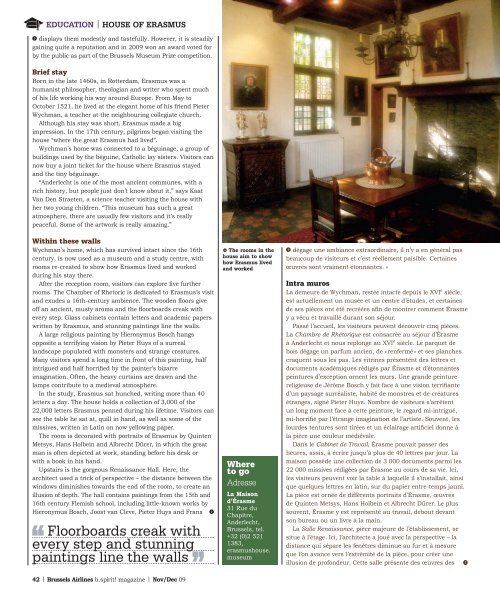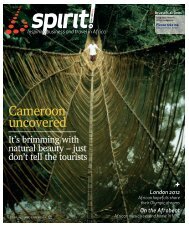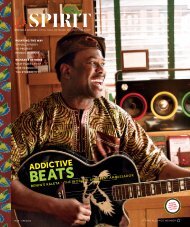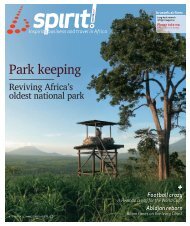You also want an ePaper? Increase the reach of your titles
YUMPU automatically turns print PDFs into web optimized ePapers that Google loves.
EDUCATION | HOUSE OF ERASMUS<br />
displays them modestly and tastefully. However, it is steadily<br />
gaining quite a reputation and in <strong>2009</strong> won an award voted for<br />
by the public as part of the Brussels Museum Prize competition.<br />
Brief stay<br />
Born in the late 1460s, in Rotterdam, Erasmus was a<br />
humanist philosopher, theologian and writer who spent much<br />
of his life working his way around Europe. From May to<br />
October 1521, he lived at the elegant home of his friend Pieter<br />
Wychman, a teacher at the neighbouring collegiate church.<br />
Although his stay was short, Erasmus made a big<br />
impression. In the 17th century, pilgrims began visiting the<br />
house “where the great Erasmus had lived”.<br />
Wychman’s home was connected to a béguinage, a group of<br />
buildings used by the béguine, Catholic lay sisters. Visitors can<br />
now buy a joint ticket for the house where Erasmus stayed<br />
and the tiny béguinage.<br />
“Anderlecht is one of the most ancient communes, with a<br />
rich history, but people just don’t know about it,” says Kaat<br />
Van Den Straeten, a science teacher visiting the house with<br />
her two young children. “This museum has such a great<br />
atmosphere, there are usually few visitors and it’s really<br />
peaceful. Some of the artwork is really amazing.”<br />
Within these walls<br />
Wychman’s home, which has survived intact since the 16th<br />
century, is now used as a museum and a study centre, with<br />
rooms re-created to show how Erasmus lived and worked<br />
during his stay there.<br />
After the reception room, visitors can explore fi ve further<br />
rooms. The Chamber of Rhetoric is dedicated to Erasmus’s visit<br />
and exudes a 16th-century ambience. The wooden fl oors give<br />
off an ancient, musty aroma and the fl oorboards creak with<br />
every step. Glass cabinets contain letters and academic papers<br />
written by Erasmus, and stunning paintings line the walls.<br />
A large religious painting by Hieronymus Bosch hangs<br />
opposite a terrifying vision by Pieter Huys of a surreal<br />
landscape populated with monsters and strange creatures.<br />
Many visitors spend a long time in front of this painting, half<br />
intrigued and half horrifi ed by the painter’s bizarre<br />
imagination. Often, the heavy curtains are drawn and the<br />
lamps contribute to a medieval atmosphere.<br />
In the study, Erasmus sat hunched, writing more than 40<br />
letters a day. The house holds a collection of 3,000 of the<br />
22,000 letters Erasmus penned during his lifetime. Visitors can<br />
see the table he sat at, quill in hand, as well as some of the<br />
missives, written in Latin on now yellowing paper.<br />
The room is decorated with portraits of Erasmus by Quinten<br />
Metsys, Hans Holbein and Albrecht Dürer, in which the great<br />
man is often depicted at work, standing before his desk or<br />
with a book in his hand.<br />
Upstairs is the gorgeous Renaissance Hall. Here, the<br />
architect used a trick of perspective – the distance between the<br />
windows diminishes towards the end of the room, to create an<br />
illusion of depth. The hall contains paintings from the 15th and<br />
16th century Flemish school, including little-known works by<br />
Hieronymus Bosch, Joost van Cleve, Pieter Huys and Frans<br />
Floorboards creak with<br />
every step and stunning<br />
paintings line the walls<br />
42 | Brussels Airlines b.spirit! magazine | Nov/Dec 09<br />
n The rooms in the<br />
house aim to show<br />
how Erasmus lived<br />
and worked<br />
Where<br />
to go<br />
Adresse<br />
La Maison<br />
d’Érasme<br />
31 Rue du<br />
Chapitre,<br />
Anderlecht,<br />
Brussels, tel.<br />
+32 (0)2 521<br />
1383,<br />
erasmushouse.<br />
museum<br />
dégage une ambiance extraordinaire, il n’y a en général pas<br />
beaucoup de visiteurs et c’est réellement paisible. Certaines<br />
œuvres sont vraiment étonnantes. »<br />
Intra muros<br />
La demeure de Wychman, restée intacte depuis le XVI e siècle,<br />
est actuellement un musée et un centre d’études, et certaines<br />
de ses pièces ont été recréées afi n de montrer comment Érasme<br />
y a vécu et travaillé durant son séjour.<br />
Passé l’accueil, les visiteurs peuvent découvrir cinq pièces.<br />
La Chambre de Rhétorique est consacrée au séjour d’Érasme<br />
à Anderlecht et nous replonge au XVI e siècle. Le parquet de<br />
bois dégage un parfum ancien, de « renfermé » et ses planches<br />
craquent sous les pas. Les vitrines présentent des lettres et<br />
documents académiques rédigés par Érasme et d’étonnantes<br />
peintures d’exception ornent les murs. Une grande peinture<br />
religieuse de Jérôme Bosch y fait face à une vision terrifi ante<br />
d’un paysage surréaliste, habité de monstres et de créatures<br />
étranges, signé Pieter Huys. Nombre de visiteurs s’arrêtent<br />
un long moment face à cette peinture, le regard mi-intrigué,<br />
mi-horrifi é par l’étrange imagination de l’artiste. Souvent, les<br />
lourdes tentures sont tirées et un éclairage artifi ciel donne à<br />
la pièce une couleur médiévale.<br />
Dans le Cabinet de Travail, Érasme pouvait passer des<br />
heures, assis, à écrire jusqu’à plus de 40 lettres par jour. La<br />
maison possède une collection de 3 000 documents parmi les<br />
22 000 missives rédigées par Érasme au cours de sa vie. Ici,<br />
les visiteurs peuvent voir la table à laquelle il s’installait, ainsi<br />
que quelques lettres en latin, sur du papier entre-temps jauni.<br />
La pièce est ornée de différents portraits d’Érasme, œuvres<br />
de Quinten Metsys, Hans Holbein et Albrecht Dürer. Le plus<br />
souvent, Érasme y est représenté au travail, debout devant<br />
son bureau ou un livre à la main.<br />
La Salle Renaissance, pièce majeure de l’établissement, se<br />
situe à l’étage. Ici, l’architecte a joué avec la perspective – la<br />
distance qui sépare les fenêtres diminue au fur et à mesure<br />
que l’on avance vers l’extrémité de la pièce, pour créer une<br />
illusion de profondeur. Cette salle présente des œuvres des











